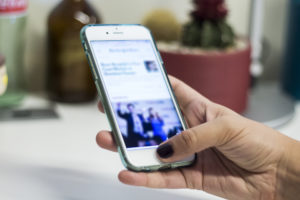Why Your Office Needs a BYOD Policy

[vc_row][vc_column][vc_column_text]The holidays are coming and with them come the latest and greatest smart devices. Lots of people will find a new watch, phone or tablet in their stockings this year. This is both a boon and a bane for business managers who say employees can “bring your own devices” (BYOD) to work to access the company network and resources.
It can be simpler to do both personal and professional work on a single device. No one wants to carry around two smart phones in order to keep work issues separate from home issues. According to a report, 67 percent of workers use their personal devices at the office. For this reason, it is important that your company have a mobile device management (MDM) policy to protect both company assets and employee efficiency.
Lower your risk with BYOD and MDM
Two policies and procedures should be in place before employees start mixing business with pleasure. The first is the BYOD policy. Establish clear rules about who is allowed to use what technology at work. For example, are employees allowed to use personal phones to connect to the company network and access company materials? What about tablets? Seventy-seven percent of employees have not received any instructions about problems that may arise when it comes to using their personal device in the workplace. It’s important to establish what devices your BYOD policy supports – and what devices aren’t supported. The second is MDM software. There are several MDM packages on the market, but they all essentially do the same thing — track location and turn off, lock or completely blank out an errant or lost mobile device.
Better to be safe than sorry.
MDM software can use a smart device’s GPS to track its location. For some companies it is important to know where any device that has access to sensitive material is at all times. With a transparent policy in place, employees will clearly understand that bringing their new device to work means an employer may need to keep tabs on it.
Simple security measures are your friend.
 Less than 10 percent of organizations can account for all of the devices that connect to their network. If employees are accessing sensitive data on personal devices, security measures must be in place. For example, make sure all BYOD devices are password protected. Also, make sure the device will automatically lock when it is idle for a short time. Combine this with rules about what types of downloads are permissible and you’re taking the basic steps toward protecting your company and the rights of your employees.
Less than 10 percent of organizations can account for all of the devices that connect to their network. If employees are accessing sensitive data on personal devices, security measures must be in place. For example, make sure all BYOD devices are password protected. Also, make sure the device will automatically lock when it is idle for a short time. Combine this with rules about what types of downloads are permissible and you’re taking the basic steps toward protecting your company and the rights of your employees.
Make sure everyone understands what’s at stake.
When accessing the company network, should some websites be blocked? Will employees have access to information that’s so sensitive you’ll want to disable phone cameras while at work? The rules should cover all this as well as the straightforward misuse of personal devices for harassment or transmitting and receiving illicit materials.
The company should offer training for everyone so they understand what is permitted and prohibited. Employees should also understand that the company will be tracking their personal device and their behavior while using it. Get everyone together at once and explain why it’s important for the security of the company and their jobs.
Who pays for data overage charges?
Your BYOD policy should lay out what is expected in terms of data use, what the company will pay for and who will cover any data overage charges when too many people stream “The Walking Dead” on their phones during lunch.
[/vc_column_text][wproto_quote text=”Less than 10 percent of organizations can account for all of the devices that connect to their network.”][/vc_column][/vc_row][vc_row][vc_column][vc_column_text]An employee leaves, what happens next?
If your company is tracking an employee’s personal device and that employee leaves to work elsewhere, the MDM software can remotely erase data from it. The problem is that most software can’t tell the difference between personal vacation photos and patent applications, medical records or balance sheets. Employers have to be up front about plans to erase the devices and employees need a clear plan for backing up their own data before the wipe.
BYOD policies and MDM software are there for a reason. Employees should understand that using a personal device to access your company’s network is a convenience that comes with certain responsibilities. This may make their device subject to your authority as the employer. What they do on company time can and will be monitored. These steps are a way to mitigate the risk not just of employees goldbricking on company time, but also of viruses and malware that could find their way onto company servers by piggybacking on someone’s smart phone.[/vc_column_text][/vc_column][/vc_row][vc_row][vc_column][/vc_column][/vc_row]









